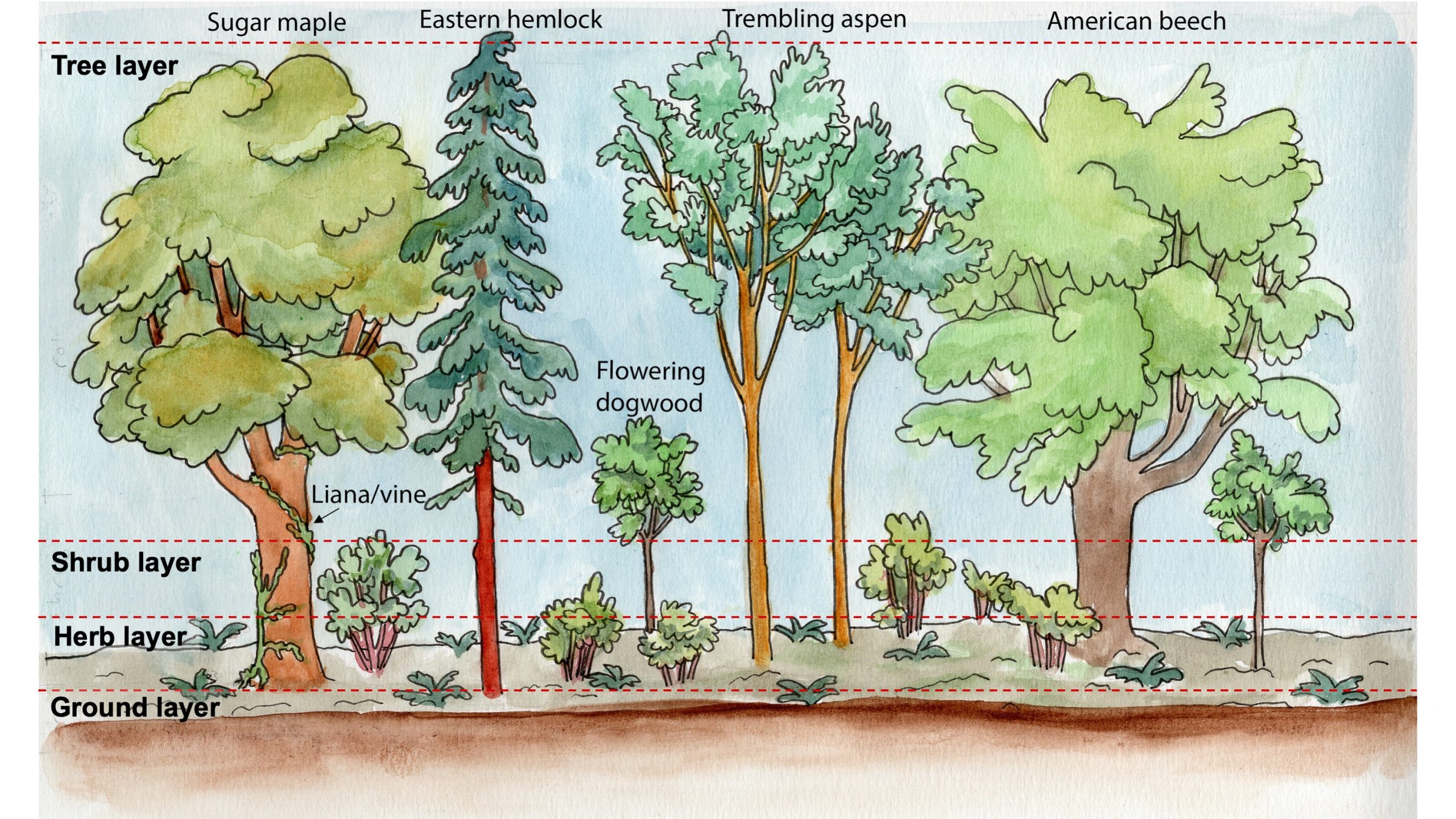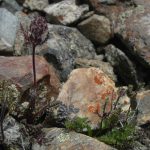In order to complete this lab, some background information in forest ecosystems, plant succession and disturbance processes is required.
Forest Ecosystems, Ecological Disturbance and Plant Succession
Disturbance is a pervasive process in ecosystems. In the context of vegetation dynamics, it may be defined as any event that destroys part or all of the above ground vegetation in an ecosystem. Disturbance includes wildfire, flooding, large scale disease outbreaks, and major windstorms. Once viewed as a negative force acting on ecosystems, disturbance is now recognized as integral and essential to the function of many ecosystems. In forest ecosystems fire is often a critical disturbance. It has been a regular feature of BC’s dry interior ecosystems and even to some degree in the wetter coastal regions of this field trip. Fire adapted species require regular, frequent fires to remove competition, prepare the soil for their seed by removing litter and, for some conifers, provide the intense heat needed to open cones and release seeds. Without periodic fires, species in fire-prone ecosystems would gradually be replaced with less fire-adapted species.
For millennia in North America, wildfires were ignited by lightning or indigenous peoples. However, European settlers engaged in fire suppression in many ecosystems for decades. Thanks to growing scientific evidence, land managers now recognize fire’s role and, over the last several decades, have begun to implement “controlled” or “prescribed” burns to restore this critical ecosystem process. Nevertheless, catastrophic fires have becoming increasingly frequent and intense in recent years due to a combination of factors, including previous fire suppression and buildup of dead wood that increases fuel loads, as well as hotter, drier conditions and insect outbreaks associated with climate change. Although these newsworthy catastrophic fires have had tragic consequences for human populations, fire must be recognized as a critical ecosystem process in many systems, and considered in conservation and management agendas (Hewitt in Arbogast et al. 2018).
Plant succession refers to gradual changes in plant community composition and structure that occur following large-scale disturbance (e.g., fire, logging or cultivation) or on areas of new terrain (e.g., recently exposed glacial till, lava flows). Initial colonizing plant species are referred to as “pioneer” species. These are plants that arrive quickly via effective seed dispersal or that are adapted to grow rapidly in the open, well-lit conditions of early succession. Other names for pioneer species include r-strategists and early-successional species. They may contribute to the establishment of additional species via root penetration and the cycling of organic material and minerals in the soil, though their role may be less pivotal in facilitating subsequent plant populations than once assumed. Later in succession, additional plant species establish populations as their seeds arrive from neighbouring sites, or, if the substrate is intact (e.g., following fire), as they emerge from buried seed and vegetative plant parts in the soil. In time, trees and shrubs may establish and mature, casting shade and altering the microclimate at ground level. The changes in humidity and soil temperature create conditions for shade-adapted understory plant species to establish. If major disturbance such as fire or human activity does not occur, an increasingly complex community structure may develop, and species more adapted to recruiting in shady understory conditions may dominate. These mid-to-late successional species are sometime categorized as k-strategists (and even “climax” species).
Succession was previously considered a relatively predictable process in which a sequence of plant communities replaced one another in a unidirectional process, with a stable endpoint called a “climax” community. Today, it is recognized to be a much less orderly process. The particular sequence of changes may be random as a result of stochastic processes such as dispersal that affect which species will establish. Patterns of succession may vary even across similar sites within one ecological region. Further, given the prevalence of disturbances, succession may be interrupted and “reset,” for example in fire-prone ecosystems, so there is no guarantee that the elusive “climax” community will take hold. Thus, while this idea of a uniform, highly predictable successional process continues to be articulated in many university textbooks, the evidence exists for a more stochastic, less predictable trajectory of change (Johnson and Miyanishi 2008).
11.PR2: Background Information about the tour location
Park History:
The Park was initially a part of the UBC Endowment Lands which were set aside in 1923 by the BC government to be used as a source of revenue for the fledgling University of British Columbia. Logging for export to European markets was the main revenue generator. Eventually, all but a narrow band of forest along the western tip of Point Grey was harvested. Today the forest is mostly second growth that established after logging or more recent disturbances. In 1975, the provincial government designated part of the UBC Endowment Lands as an ecological reserve and Pacific Spirit Park was established in 1989 (UBC Geography, 2020).
Vegetation and Soils
Both human activity and soils influence the tree and understory plant species across the park. Differences in the kind of past disturbance as well as the severity and timing, have contributed to the patchwork of varied plant associations throughout the park. The soils vary considerably among locations, although they are influenced by the same general climate and have common parent materials. Podzols underlie much of the Park and are characterised by a leached layer where minerals and decayed organic matter have been removed by rain seeping through the soil. Differences in soils between sites can be attributed to the growth and decay of organic material, which itself varies between sites based on local topography, the distribution of water and drainage of rainfall, and vegetation cover (UBC Geography, 2020). A video interpreting the soils in the Park in the second growth needle-leaf forest is available at UBC SoilWeb here.
Dichotomous Key to Common Vascular Plants in Pacific Spirit Park
View the dichotomous Key to Common Vascular Plants in Pacific Spirit Park provided with the lab, or found in simple pictorial format here. It is important to learn how to use a plant key and to become familiar with the vocabulary used to describe plants. The vocabulary is very specific to plant taxonomy and requires some attention.

Question Set for GEOS 102 Students:
Stop #1. Broadleaf Forest
Use the dichotomous Key to Common Vascular Plants in Pacific Spirit Park to determine the dominant tree species in the broadleaf forest. The goal is to learn how to use a plant key and to become familiar with the vocabulary used to describe plants. The vocabulary is very specific to plant taxonomy. Ask questions if you are stuck.
For the dominant tree species, identify the species and give both its common and scientific name. Note: it is scientific protocol to either underline or italicize scientific names. Genus names are capitalized and the species names are lower case.
- Common name of the dominant tree (1 point).
- Scientific name of the dominant tree (1 point).
- List two diagnostic features from the key that you found most helpful to identify this species (1 point).
- What was the main disturbance that initiated this broadleaf forest? (1 point).
- Based on your observations, list two other disturbances (besides the hiking trail) that appear likely to have occurred in this forest and provide evidence for each one (2 points).
- Name the pioneer tree species in this forest. (1 point)
- Based on your observations, how might the broadleaf forest change in the future, assuming it will undergo succession without any further major disturbances? State two possible ways the forest might change/develop. (1 sentence each). (2 points)
- The trees in this forest are deciduous and lose their leaves each autumn. Do leaves contribute to organic or mineral soil horizons or both? Briefly explain (2 points).
Stop #2. Needleleaf Forest
- Use the attached Key to Common Vascular Plants in Pacific Spirit Park to identify three common tree species in the needleleaf forest. Give both their common and scientific names (see your dichotomous key or the one attached here (3 points).
Tree species 1:
Tree species 2:
Tree species 3:
- Name the dominant species (one or potentially more). Briefly explain what information you based this assertion on (what did you observe in the photospheres and/or video to suggest that this was the case)? (2 points).
- Based on your observations, list two disturbances that have occurred in this forest and provide evidence for each one (2 points).
- NB: When TA’s take students along the trail, they often complete the tour at the site of a burned out stump. Other sorts of small- and large- scale forest ecosystem disturbance types are discussed in your course readings and in this Natural Resources Canada page (in particular, their literature cited list)
- In the needle-leaf forest stand (at Stop 2) we touched on a few characteristics, or “ecosystem properties” that occur in these less-recently disturbed sites, and are important from a biodiversity standpoint. Describe one characteristic/property and explain why it matters from an ecosystem or biodiversity standpoint (1 point).
- If disturbance occurs and creates large canopy openings, which tree species do you predict will colonize the openings (there are two possibilities. One of them is growing in the canopy at this site, and acts as a sort of “pioneer species” in large openings in this otherwise mature forest). (1 point)
- One of the tree species in both forest types is found in the understorey (below the canopy) and is an introduced species (see my video as we enter the needleleaf forest). It is known for its evergreen leaves with pointed edges and red fruits. Use the key to identify this species. Where did this species come from originally? (2 points – 2 to 3 sentences).
References:
Hewitt, N. 2018. Chapter 10: Plant Geography (sections written for the 1st Can-Ed.) in Arbogast A. et al. “Discovering Physical Geography”, 1st Canadian Edition, John Wiley & Sons, Toronto
Johnson, E.A. and K. Miyanishi. 2008. Testing the assumptions of chronosequences in succession. Ecology Letters 11:419-431.
UBC Geography* (2019) Lab 4 Handout: Soils, Tree Species Composition and Disturbance History in Pacific Spirit Park. In GEOB 102, Our Changing Environment: Climate and Ecosystems, Dept. of Geog., UBC * Dr. Greg Henry developed the initial Pacific Spirit Park lab that this tour was modelled on in the 1990’s; adapted 2017-2020 by Hewitt, N.




Shannon Lyaski
October 1, 2021 — 4:01 pm
Dear Ms. Hewitt,
Awesome website!! I am a program coordinator for county parks. I am writing to ask permission to reprint your diagram of the 4 layers of the temperate forest with credit for an educational interpretive sign in our public park in Genesee County, NY. Visitors come to our county parks for free to enjoy nature and our educational exhibits. Your diagram would be printed on 1 sign here in the park as part of an Eagle Scout project, which is creation of an interpretive nature trail with 10 signs for park visitors to enjoy. Our parks reach 5,000 in-person contacts with our programming each year, and several thousands visit the parks in addition to this number. Please feel free to contact me and I thank you for your consideration.
nina hewitt
December 9, 2022 — 1:14 pm
NB: I responded to this via email and the answer was yes!
Damien Mullins
December 9, 2022 — 11:59 am
Does anyone have the answers for these?
nina hewitt
December 9, 2022 — 1:16 pm
Hi Damien, These are questions for an assignment about the VR. Can you let me know why you are asking?